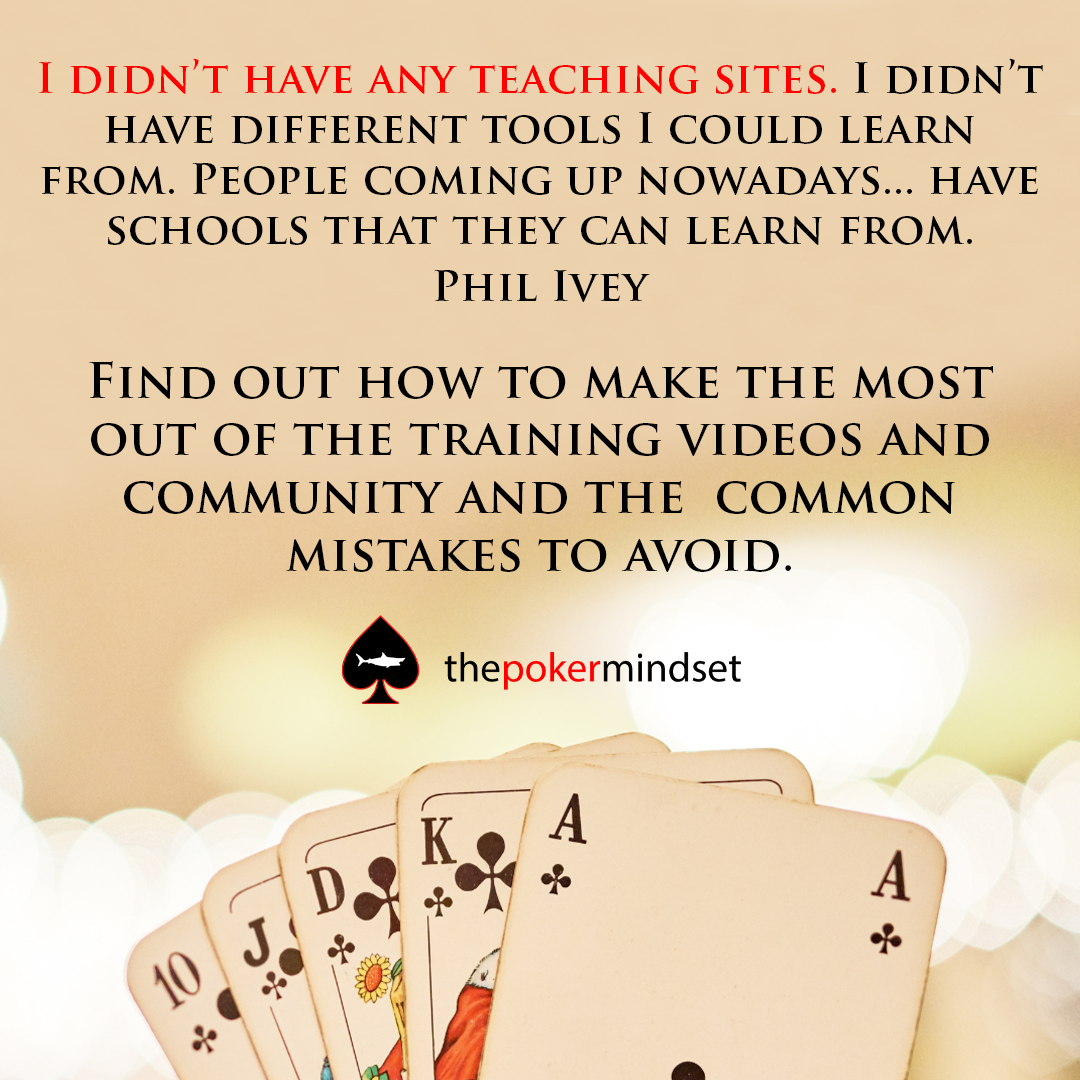
“Show me a successful individual and I’ll show you someone who had real positive influences in his or her life. I don’t care what you do for a living – if you do it well I’m sure there was someone cheering you on or showing the way. A mentor.”
Denzel Washington
Now Denzel doesn’t play poker for a living but the same principles apply for any endeavour. Success at the highest levels can’t be done alone. The best in any field always learn from peers and mentors.
Training sites like RunItOnce are one of the most effective ways to improve in poker. Having the world’s best players and coaches give their thought process in hand histories, live play, and solvers, gives players of all levels the opportunity to gain insights they would never see alone. There is something for everyone. Beginners to high stakes grinders will always learn something and the content is tailored to players specific levels and needs. There are paths laid out for new players to learn the fundamentals, the latest strategies for high stakes players to learn from the best minds in the game, and everything in between. The coaching roster at RunItOnce especially is immense.
To rise through the stakes in today’s game requires a strong understanding of the fundamentals, game theory, and exploitative play. Learning from players who have been through it all is essential to speed up the learning curve.
In this article we’ll discuss how to make the most out of the training videos and community, common mistakes to avoid, and better alternatives for the more serious grinders. Although, the alternatives should be used in tandem with training videos anyway.
How to make the most out of training sites
- Have a plan
- Take notes
- Ask questions in the comments or in the community
- Find a study partner
- Focus on one or two areas to improve at a time, and apply what you learn and seek immediate feedback
Have a plan
What are your current strengths? Which spots give you the most trouble? How’s your general theory?
These types of questions should be explored before a player dives deep into improving their game. Knowing where his/her strengths and weaknesses are is important for efficient learning. It was explained in ‘The Mental Game of Poker’ by Jared Tendler, that all learning should be approached like ‘an inchworm’.

The following passage from the book explains in more detail:
“If you’ve never seen the way an inchworm moves, it starts by stretching its body straight, anchors the front “foot,” then lifts up from the back end, bends at the middle to bring to two ends closer together, anchors the back foot, and then stretches its body straight again so it can take another step forward.
When you reach a new peak in your ability, the front end of your range takes a step forward. Your best just became better, which also means that your range has widened because the worst part of your game hasn’t moved yet. The most effective way to move forward again is to turn your focus to the back end of your range and make improvements to your greatest weaknesses. By eliminating what is currently the worst part of your game, your bell curve takes a step forward from the back end, and now it’s easier to take another step forward from the front.
The inchworm concept illustrates how consistent improvement happens by taking one step forward from the front end followed by another step forward from the back.”
Jared Tendler
Knowing where your strengths and weaknesses are is essential for moving your learning curve in the most effective way. If you’ve just learned a new concept that enhances the strongest part of your game, then you know it’s wise to focus on improving a weak area of your game. For example, someone might have just learned the theory behind double barreling turns vs the big blind, but still has trouble cbetting out of position as the preflop raiser. It would make sense that after learning double barreling theory vs the big blind, that they next focus on fixing their out of position cbets. It could be anything, everyone has different strengths and weaknesses at different times. It’s important that you’re not busy learning new concept after new concept because while it feels like a lot is happening, in actuality, the gap between your worst and your best just keeps growing which can be disastrous.
Before just diving into videos without a plan or direction, identity strengths and weaknesses, then find videos specific to those needs. There are videos on RunItOnce covering every part of the game.

Take notes
Scientific studies prove that students who take notes retain the information better, and even better with a pen and paper rather than a laptop or phone. How many times have you watched a training video or read an article, then completely forgot most of it a few days later? Unless you take notes this will always be the case.
Note taking forces people to focus deeply on the information. It helps them think about the topic as it applies to their own life, and helps them think critically about what’s being said.
Skimming through training videos might feel like stuff is getting done, but really most of the information is lost, and there’s a risk of misapplying concepts in-game which can be very costly as they’re not fully understood.
Listen carefully, summarize, think in the context of your own game, and question anything that isn’t fully understood.
Ask questions in the comments or community
Most coaches respond to comments on their videos, that is a golden opportunity for players to learn specifically to their needs from some of the best in the game. Asking questions and interacting with high level players deepens players’ understanding of the game, and helps retain information.
There’s also a community where players can interact with each other and the coaches. These interactions are one of the most powerful ways to improve, and is something every crusher has in common. Every player who made it to the top all talked about the importance of discussing hands and strategy with other players. A lot of EV is lost by not taking advantage of these opportunities waiting to be tapped into every day.
You don’t know what you don’t know. The responses that come back are very often surprising and uncovers all kinds of blind spots.
If you don’t already, start interacting with other players today. Be vulnerable. Exposing weak areas is scary at first because no one likes looking stupid, but it’s one of the fastest ways to improve, and most don’t care if others show blunders. In fact, they care about helping players improve. Everyone started from the bottom, and everyone including the game’s elites still make mistakes.
Be curious and expose yourself.

Find a study partner
Working with players on similar levels helps players stay curious and excited because it’s like a friendly competition where they rise together. When one improves the other is motivated to keep going. Poker is tough with many brutal periods so having someone to study with and share the journey with keeps things exciting through all the ups and downs.
With a study partner you can share notes from videos, work on strengths and weaknesses together, discover solutions together and ask better questions together. Working together challenges each other to stay ahead. Another important piece of the poker puzzle.
Focus on one or two areas to improve at a time, apply what you learn and seek immediate feedback
Focusing on too many things at once is overwhelming and ineffective. Information will be lost, the gap between the best and worst will be too wide, and concepts will be misapplied in game.
Poker is a big game which takes a long time to learn. Have patience and focus on learning each new concept, and improving each weakness individually until they’re learned at a high level. This will improve your game much better than trying to learn lots of different things at once, in an unstructured manner.
After learning a new concept or working on a weakness, apply it in game, mark spots related, and send hands to players and coaches. Do it while it’s fresh immediately after studying. When you feel like enough work has been done and you’re feeling confident in these areas, identify the next areas you want to improve and keep going this way. It’s the most effective way to learn and improve. No rush.
Common mistakes to avoid
- Not taking notes
- Watching videos while distracted by social media, browsing, etc.
- Watching videos to fall asleep to
- Not asking questions and interacting with other players
- Trying to learn lots of different concepts at once
- Watching videos with no plan
Training sites are highly effective if done right, but a serious grinder must still seek one on one coaching, and learn how to use study tools themselves. There’s no replacement for learning and using tools such as GTO solvers, Flopzilla, PokerTracker, HoldemManager, etc., because here players have the opportunity to play around with variables and learn how it applies to spots specific to their game.
Self-study, working with others, and training videos are all essential to the development of any poker player, and crucial for a quicker rise through the stakes.
Do you want to learn from the best and interact with other hungry players every day? RunItOnce has training videos of all levels and a community of like-minded players designed to give players the perfect learning environment.


